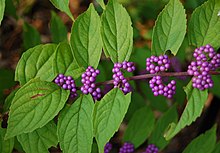Beautyberry
| Callicarpa | |
|---|---|
 |
|
| Callicarpa dichotoma 'Early Amethyst' (Purple Beautyberry) | |
| Scientific classification | |
| Kingdom: | Plantae |
| (unranked): | Angiosperms |
| (unranked): | Eudicots |
| (unranked): | Asterids |
| Order: | Lamiales |
| Family: | Lamiaceae |
| Genus: |
Callicarpa L. |
| Synonyms | |
|
|
Callicarpa (beautyberry) is a genus of shrubs and small trees in the family Lamiaceae. They are native to east and southeast Asia (where the majority of the species occur), Australia, Madagascar, southeast North America and South America.
The temperate species are deciduous, the tropical species evergreen. The leaves are simple, opposite, and 5–25 cm long. The flowers are in clusters, white to pinkish. The fruit is a berry, 2–5 mm diameter and pink to red-purple with a highly distinctive metallic lustre, are very conspicuous in clusters on the bare branches after the leaves fall. The berries last well into the winter or dry season and are an important survival food for birds and other animals, though they will not eat them until other sources are depleted. The berries are highly astringent but are made into wine and jelly. Callicarpa species are used as food plants by the larvae of some Lepidoptera species including Endoclita malabaricus and Endoclita undulifer.
American Beautyberry Callicarpa americana is native to the southeastern United States. It can typically reach 1 to 2 meters in height. A jelly can be made from its ripe berries.
Bodinier's Beautyberry Callicarpa bodinieri, native to west-central China (Sichuan, Hubei, Shaanxi), is more cold-tolerant than C. americana, and is the species most widely cultivated in northwestern Europe. It can reach 3 meters tall.
...
Wikipedia
